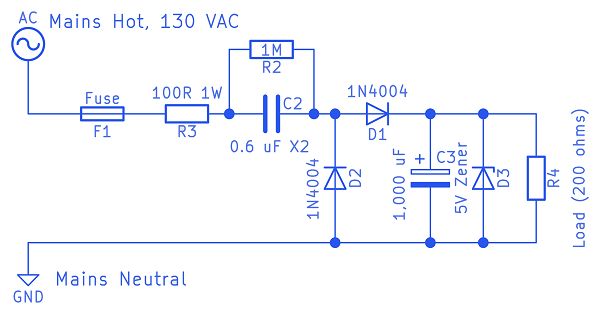Often in many project you need to have a mains power supply. Let’s say you are doing home automation project, you need to power the circuit using AC supply. Because battery is an appropriate option in that project since you need to fit the circuit in electric board of your home. So we have to drop the AC voltage. According to Ohm’s law formula, we can drop the AC or DC voltage by adding a resistor in series. In the case of DC there will not any problem, since we can use a resistor to drop the voltage across any device. Of course we can use a resistor in not a sensitive device to negative voltages. Although mains voltage is very high and we need let’s say 5 volt, so we have to drop very large voltage across the resistor.
So, power loss will be way more than we need. This is not efficient way to drop a mains voltage. For mains voltage we can do a trick, we can replace resistor with capacitor for drop mains voltage. This is called capacitive dropper circuit. The main component in this circuit is the capacitor which drop the AC voltage due to its reactance.
Of course we can use SMPS for very advanced project for better efficiency and nowadays almost all mobile phone charger offers SMPS circuit. But for a small project this SMPS is a bit expensive and not convenient to use.
How capacitor drop AC voltage and its formula
As we all know that capacitor acts like resistor with AC voltages due to its reactance. We can this to drop the voltage of mains voltage. The formula for reactance is –
Using this formula we can calculate the reactance of a capacitor for any frequency. But we have to calculate the value of capacitor for a reactance for mains frequency. So, we have to arrange the formula a little.
Using this formula we can calculate the value of capacitor which can give the reactance which we need for mains frequency.
Calculating the capacitance for 45KΩ reactance in 50Hz AC voltage
Let’s say we need 5 volts and 5mA at output. Mains voltage is 230 volts so we need to drop 225 volts across capacitor. So, after calculating the reactance (resistor) value we got 45kΩ.
So, we will calculate the capacitor value for 45kΩ and mains frequency is 50HZ.
C= 0.00000007074
C = 0.0707mF
Now capacitor of this value will give the 45kΩ reactance for mains voltage. We have to connect it in series with mains voltage and load. You can use value near the calculated value and capacitor type will be MKP10 or X2 (safety capacitor).
But this circuit is not complete yet. We have to use the current limiting resistor to prevent the capacitor inrush current. Otherwise the LED will blow up.
Capacitive dropper circuit
In this circuit we have used two resistor- R1 and R2. Resistor R1 is used to discharge the capacitor and R2 is used to limit the inrush current of capacitor. This circuit is OK for LEDs but when device is sensitive we need a bridge rectifier to remove negative voltages. And another output capacitor for smooth out output voltage ripples.
Here full bridge rectifier converts AC voltages into DC, zener diode is used to regulate the output voltage at 5 volts and capacitor C2 is used to smooth the output voltage. Fuse is added for safety purpose.
This circuit draws 5mA current from mains voltage even while no load is attached. Let’s see why?
We can calculate the current if we know the overall impedance at AC side. For finding the overall impedance we can combine the reactance of capacitor and resistance of resistor as shown.
Now we can calculate the current flowing through the circuit.
As we know that I = V/R
I = 230/45002.778Ω
I = 5.11mA
Now this also the amount of maximum current we can draw from output. If we draw more than 5mA at the output, our stable 5 volt output will break down. If you need more than 5 volts, you can increase the value of capacitor C1.
Caution: – Do not touch any parts of circuit even output 5 volts with naked hand. Because this voltage can be referenced with live and neutral both according to polarity of AC input. Always wear globes and shoes while working with mains voltages.

I just built a 220v powered led based on your circuit and built it into my usb mains switch. Works like a charm!
It is actually a great and helpful piece of information. I am glad that you shared this useful information with us. Please keep us informed like this. Thanks for sharing.
I discovered your weblog web site on google and examine a few of your early posts. Continue to maintain up the superb operate. I simply extra up your RSS feed to my MSN Information Reader. Seeking ahead to reading extra from you later on!?